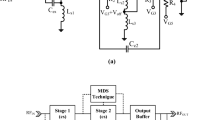Abstract
A highly linear 5.5 GHz low noise amplifier (LNA) has been designed exploiting source inductive degeneration topology by using post distortion linearization techniques in 0.18 m CMOS technology. This technique improves the input third order intercept point \((IIP_{3})\) of a low noise amplifier. For enhancing the linearity, this technique used a diode connected MOSFET as IMD sinker and forward body biased which is done in cadence tool. The proposed low noise amplifier achieves high \(IIP_{3}\) by using two transistors, main and auxiliary transistors. Also source inductive degeneration topology is employed in the proposed LNA to optimize the noise figure (NF) and \(S_{11}\) at high frequency. In order to reduce power consumption and threshold voltage, Forward Body Biased technique was implemented. In this paper, the first section discusses the most widely used eight linearization techniques and in the second section, the proposed circuit is represented along with its employed topology, techniques and the simulated results. The proposed LNA achieves a simulated third order input intercept \((IIP_{3})\) of 9.20 dBm while consuming 10.8 mW from a power supply of 1.8 V. it also exhibits a measured gain of 11.34 dB and NF, NF of 2.33 dB.



















Similar content being viewed by others

References
Aya M, Thierry T, Yann D, Jean-Baptiste B (2003) A very low voltage low power CMOS low noise amplifier with forward body bias. IEEE, Aug 2010.468
Bowick C, Blyler J, Ajluni C (2007) RF circuit design, 2nd edn. Newnes, London
Chang CP, Chen JH, Hung SH, Su CC, Wang YH (2009) A novel post linearization technique for fully integrated 5.5 GHz high-linearity LNA. In: IEEE international innovative computing, information and control conference, Kaohsiung, Taiwan, pp 577–580
Chang C-P, Chien W-C, Su C-C, Wang Y-H (2010) Linearity improvement of cascade CMOS LNA using a diode connected NMOS transistor with parallel RC CKT
Cheng W, Annema AJ, Croon JA, Klaasen DBM, Nauta B (2008) A general weak nonlinearity model for LNAs. In: Proceedings of IEEE custom integrated circuits conference, pp 221–224
Chen F, Zhang W, Rhee W (2013) A 3.8-mW 3.54-GHz regenerative FM-UWB receiver with enhanced linearity by utilizing a wideband LNA and dual bandpass filters. IEEE Trans Microw Theory Tech 61(9):3350–3359
Chu Y-K, Liao C-H, Chuang H-R (2003) 5.7 GHz 0.18/spl mu/m CMOS gain-controlled LNA andmixer for 802.11a WLAN applications. In: 2003 IEEE radio frequency integrated circuits (RFIC) symposium, pp 221–224
Ellinger F (2008) Radio frequency integrated circuits and technologies, 2nd edn. Springer, Berlin
Fan X, Zhang H, Snchez-Sinencio E (2008) A noise reduction and linearity improvement technique for a differential cascode LNA. IEEE J Solid State Circuits 43(3):588–599
Fan X, Snchez-Sinencio E, Silva-Martinez J (2005) A 3 GHz–10 GHz common gate ultra wide band low noise amplifier. In: Proceedings of IEEE midwest symposium on circuits and systems, pp 631–634
Ganesan S, Snchez-Sinencio E, Silva-Martinez J (2006) A highly linear low noise amplifier. IEEE Trans Microw Theory Tech 54(12):4079–4085
Hsieh H-H, Wang J-H, Lu L-H (2008) Gain-enhancement techniques for CMOS folded cascode LNAs at low-voltage operations. IEEE Trans Microw Theory Tech 56(8):1807–1816
Im D, Nam I, Kim H, Lee K (2009) A wide band CMOS low noise amplifier employing noise and IM2 distortion cancellation for a digital TV tuner. IEEE J Solid State Circuits 44:686–698
Kim TW, Kim B, Lee K (2003) Highly linear RF CMOS amplifier and mixer adopting MOSFET transconductance linearization by multiple gated transistors. In: IEEE radio frequency integrated circuits symposium, pp 107–110
Kim B, Ko J-S, Lee K (2000) A new linearization technique for MOSFET RF amplifier using multiple gated transistors. IEEE Microw Guided Wave Lett 10:371–373
Kim T-S, Kim B-S (2006) Post-linearization of cascode CMOS LNA using folded PMOS IMD sinker. IEEE Microw Wirel Compon Lett 16(4):182–184
Kim N, Aparin V, Barnett K, Persico C (2006) A cellular-band CDMA CMOS LNA linearized using active post-distortion. IEEE J Solid State Circuits 41(7):1530–1534
Lee TH (1998) The design of CMOS radio-frequency integrated circuits. Cambridge Univ. Press, Cambridge
Leroux P, Steyaert M (2006) LNA ESD co design for fully integrated CMOS wireless receivers. Springer, Netherlands
Liu R-C, Lee C-R, Wang H, Wang C-K (2002) A 5.8-GHz two-stage high-linearity low-voltage low noise amplifier in a 0.35-um CMOS technology. In: IEEE radio frequency integrated circuits (RFIC) symposium, pp 221–224
Nguyen TK et al (2004) CMOS low-noise amplifier design optimization techniques. IEEE Trans Microw Theory Tech 52(5):1433–1442
Raja MK, Boon TTC, Kumar KN, Jau WS (2003) A fully integrated variable gain 5.75-GHz LNA with on chip active balun for WLAN. In: 2003 IEEE radio frequency integrated circuits (RFIC) symposium, pp 439–442
Razavi B, Behzad R (1998) RF microelectronics. Prentice Hall, Englewood Cliffs
Seyedhosseinzadeh N, Nabavi A (2014) A highly linear CMOS low noise amplifier for K band applications. Int J Electron 101(12):1607–1620
Taibi A, Slimane A (2013) Low power and high linear reconfigurable CMOS LNA for multi-standard wireless applications. In: IEEE conference
Thacker MB, Awakhare M (2014) Multi-standard highly linear CMOS LNA. In: International conference on electronic systems, signal processing and computing technologies
Xin C, Snchez-Sinencio E (2004) A linearization technique for RF low noise amplifier. In: Proceedings of IEEE international circuits systems symposium, Vancouver, BC, Canada, vol 4, pp 313–316
Zhang H, Fan X, Snchez-Sinencio E (2009) A low-power linearized, ultra-wide band LNA design technique. IEEE J Solid State Circuits 44(2):320–330
Zhang H, Snchez-Sinencio E (2011) Linearization techniques for low noise amplifier: a tutorial. IEEE Trans Circuits Syst I 58(1):22–36
Acknowledgments
This work is carried out at National Institute of Technology Silchar. We are thankful to Prof. F. A. Talukdar for his support. We also thank IIT Guwahati for providing the VLSI Lab for making layout.
Author information
Authors and Affiliations
Corresponding author
Rights and permissions
About this article
Cite this article
Kumar, R., Devi, A., Sarkar, A. et al. Design of 5.5 GHz linear low noise amplifier using post distortion technique with body biasing. Microsyst Technol 22, 2681–2690 (2016). https://doi.org/10.1007/s00542-015-2556-x
Received:
Accepted:
Published:
Issue Date:
DOI: https://doi.org/10.1007/s00542-015-2556-x



